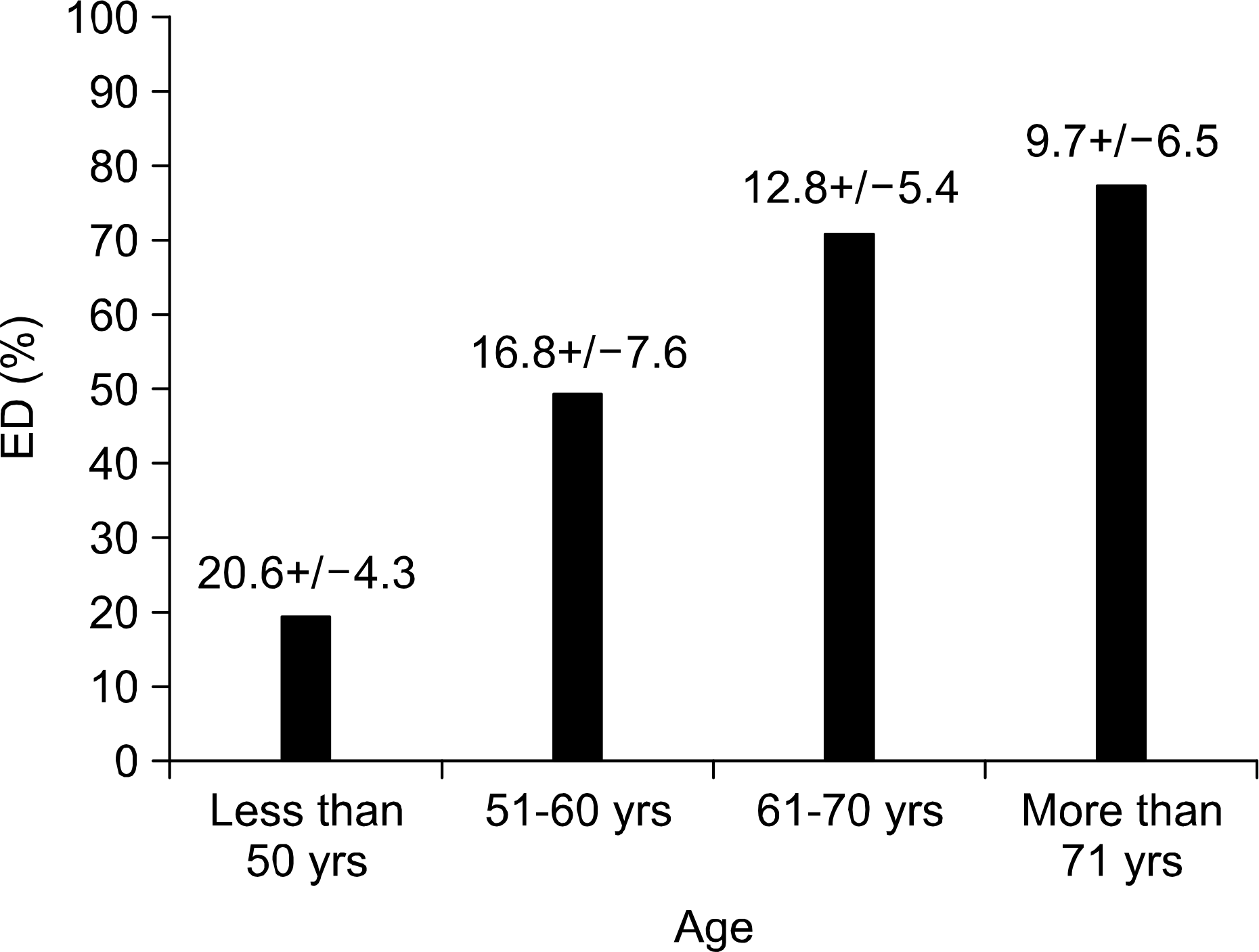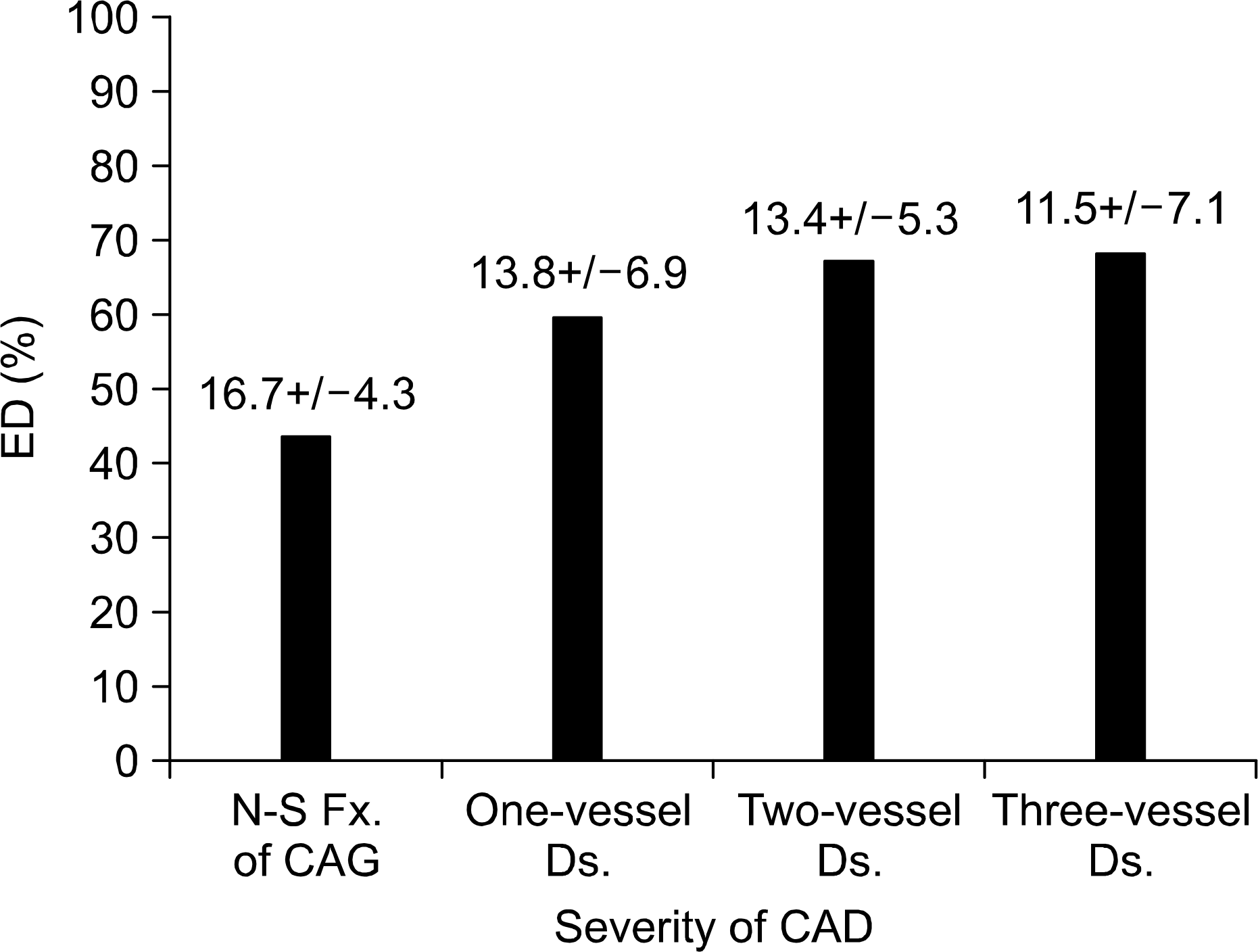Abstract
Purpose:
Erectile dysfunction (ED) may be considered as a clinical manifestation of generalized vascular disease. This study aimed to assess the correlation between ED and the severity of the involved coronary artery in patients with coronary artery disease (CAD).
Materials and Methods:
255 men with CAD, who underwent coronary angiography (CAG), were evaluated for erectile function using a questionnaire that included a 5-item Version the International Index of Erectile Function (IIEF-5). Cardiovascular risk factors were also reviewed. The correlation between erectile function and the number of involved coronary vessels, age and number of accompanying cardiovascular risk factors were analyzed.
Results:
Of the patients, 59.6% had various degrees of ED, which were subdivided into mild (21.7%), moderate (14.5%) and complete (63.8%) according to the severity. The cardiovascular risk factors were hypertension, smoking, overweight, age, lipid abnormalities and diabetes in 67.8, 67.5, 47.1, 38.4, 28.6 and 19.6%, respectively. One, two and three coronary vessels were involved in 26.3, 27.4 and 21.2%, respectively, while 25.1% showed non specific finding on CAG, despite abnormal findings in the resting ECG and treadmill exercise test. Erectile function decreased significantly according to the increasing number of involved coronary vessels (p く 0.05), age (p く 0.0㢌) and accompanying cardiovascular risk factors (p く 0.05). Of the cardiovascular risk factors, age, smoking and diabetes had negative effects on erectile function (p く 0.05) in patients with CAD.
Conclusions:
Statistically significant correlations were demonstrated between ED and the number of involved coronary vessels, age and the number of accompanying cardiovascular risk factors in patients with CAD. Furthermore, in patients with symptoms of chest discomfort, although CAG showed non specific findings, the possibility of hidden ED will need to be investigated. (Korean J Urol 2007;48:94-102)
Go to : 
REFERENCES
1.National Institutes of Health (NIH) Consensus Conference. Impotence. NIH consensus development panel on impotence. JAMA. 1993. 270:83–90.
2.Feldman HA., Goldstein I., Hatzichristou DG., Krane RJ., McKinlay JB. Impotence and its medical and psychosocial correlates: results of the Massachusetts Male Aging Study. J Urol. 1994. 151:54–61.

3.Braun M., Wassmer G., Klotz T., Reifenrath B., Mathers M., Engelmann U. Epidemiology of erectile dysfunction: results of the ' Cologne Male Survey'. Int J Impot Res. 2000. 12:305–11.
5.Park JY., Kim SW., Paick JS. How can we predict asymptomatic myocardial ischemia in patients with vasculogenic impotence? Korean J Urol. 2002. 43:67–71.
6.Kawanishi Y., Lee KS., Kimura K., Koizumi T., Nakatsuji H., Kojima K, et al. Screening of ischemic heart disease with cavernous artery blood flow in erectile dysfunctional patients. Int J Impot Res. 2001. 13:100–3.

7.Virag R., Bouilly P., Frydman D. Is impotence an arterial disorder? A study of arterial risk factors in 440 impotent men. Lancet. 1985. 1:181–4.
8.Montorsi P., Montorsi F., Schulman CC. Is erectile dysfunction the “ tip of the iceberg” of a systemic vascular disorder? Eur Urol. 2003. 44:352–4.
9.Solomon H., Man JW., Jackson G. Erectile dysfunction and the cardiovascular patients: endothelial dysfunction is the common denominator. Heart. 2003. 89:251–3.
10.Maas R., Schwedhelm E., Albsmeier J., Boger RH. The pathophysiology of erectile dysfunction related to endothelial dysfunction and mediators of vascular function. Vase Med. 2002. 7:213–25.

11.Dhabuwala CB., Kumar A., Pierce JM. Myocardial infarction and its in幻uence on male sexual function. Arch Sex Behav. 1986. 15:499–504.
12.Montorsi F., Briganti A., Salonia A., Rigatti P., Margonato A., Macchi A, et al. Erectile dysfunction prevalence, time of onset and association with risk factors in 300 consecutive patients with acute chest pain and angiographically documented coronary artery disease. Eur Urol. 2003. 44:360–4.

13.Solomon H., Man JW., Wierzbicki AS., Jackson G. Relation of erectile dysfunction to angiographic coronary artery disease. Am J Cardiol. 2003. 91:230–1.

14.Greenstein A., Chen J., Miller H., Matzkin H., Villa Y., Braf Z. Does severity of ischemic coronary disease correlate with erectile dysfunction? Int J Impot Res. 1997. 9:123–6.
15.Kloner RA., Mullin SH., Shook T., Matthews R., Mayeda G., Burstein S, et al. Erectile dysfunction in the cardiac patient: how common and should we treat? J Urol. 2003. 170:S46–50.

16.Schachinger V., Britten MB., Zeiher AM. Prognostic impact of coronary vasodilator dysfunction on adverse long-term outcome of coronary heart disease. Circulation. 2000. 101:1899–906.

17.Blumentals WA., Gomez-Caminero A., Joo S., Vannappagari V. Should erectile dysfunction be considered as a marker for acute myocardial infarction? Results from a retrospective cohort study. Int J Impot Res. 2004. 16:350–3.

18.Ruzbarsky V., Michal V. Morphologic changes in the arterial bed of the penis with aging. Relationship to the pathogenesis of impotence. Invest Urol. 1977. 15:194–9.
19.Kaiser DR., Billups K., Mason C., Wetterling R., Lundberg JL., Bank AJ. Impaired brachial artery endothelium-dependent and -independent vasodilation in men with erectile dysfunction and no other clinical cardiovascular disease. J Am Coll Cardiol. 2004. 43:179–84.

20.Son HC., Byun SS., Park EC., Cho KS., Jo MK., Kim SW, et al. Prevalence of sexual dysfunction in men older than 40 living in Seoul: epidemiologic survey using questionnaire. Korean J Urol. 2002. 43:52–61.
21.Panser LA., Rhodes T., Girman CJ., Guess HA., Chute CG., Oesterling JE, et al. Sexual function of men ages 40 to 79 years: the olmsted county study of urinary symptoms and health status among men. J Am Geriatr Soc. 1995. 43:1107–11.

22.Bancroft J., Gutierrez P. Erectile dysfunction in men with and without diabetes mellitus: a comparative study. Diabet Med. 1996. 13:84–9.

23.Klein R., Klein BE., Lee KE., Moss SE., Cruickshanks KJ. Prevalence of self-reported erectile dysfunction in people with long-term DDDM. Diabetes Care. 1996. 19:135–41.
24.Kolodny RC., Kahn CB., Goldstein HH., Barnett DM. Sexual dysfunction in diabetic men. Diabetes. 1974. 23:306–9.

25.Shin HS., Choi HK. The etiology of diabetic impotence. Korean J Urol. 1990. 31:442–5.
26.Benvenuti F., Bondnelli L., Vignoli GC. Male sexual impotence in diabetes mellitus: vasculogenic versus neurogenic factors. Neurourol Urodyn. 1993. 12:145–51.

27.Gazzaruso C., Giordanetti S., De Amici E., Bertone G., Falcone C., Geroldi D, et al. Relationship between erectile dysfunction and silent myocardial ischemia in apparently uncomplicated type 2 diabetic patients. Circulation. 2004. 110:22–6.

28.Cohn PF. Prognosis for patients with different types of silent coronary artery disease. Circulation. 1987. 75:1133–5.
29.Derby CA., Barbour MM., Hume AL., McKMay JB. Drug therapy and prevalence of erectile dysfunction in Massachusetts Male Aging Study cohort. Pharmacotherapy. 2001. 21:676–83.
Go to : 
 | Fig. 1.Relationship between ED/IIEF-5 and age (p<0.001, pく 0.001). ED: erectile dysfunction, IIEF-5: 5-item Version the International Index of Erectile Function. |
 | Fig. 2.Relationship between ED/IIEF-5 and severity of CAD (p=0.003, p>0.05). ED: erectile dysfunction, IIEF-5: 5-item Version the International Index of Erectile Function, CAD: coronary artery disease, N-S Fx.: non-specific finding, CAG: coronary angiography, Ds.: disease. |
Table 1.
Clinical characteristics of the patients
Table 2.
Prevalence of ED and risk factors in the patients with CAD
Table 3.
Clinical characteristics of the patients with CAD according to the CAG results
Table 4.
Multivariate analysis of the accompanying cardiovascular risk factors for ED according to the CAG results in patients with CAD
Table 5.
Multivariate analysis of the accompanying cardiovascular risk factors for ED in patients with CAD
Table 6.
Analysis of the relationship of ED to various medications in patients with CAD




 PDF
PDF ePub
ePub Citation
Citation Print
Print


 XML Download
XML Download